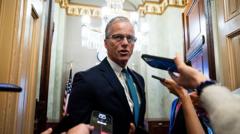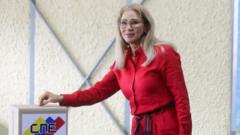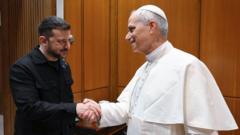The conclave to elect a new pope continues at the Vatican, with 133 cardinals reconvening for further voting after a first day failed to yield a majority.**
Vatican Conclave Embarks on Second Day of Papal Voting**

Vatican Conclave Embarks on Second Day of Papal Voting**
133 Cardinals Seek Consensus in Next Papal Election Amid Challenges and Uncertainty.**
The papal conclave is once again alive with anticipation as the 133 cardinals responsible for selecting the new leader of the Roman Catholic Church prepare for another round of voting on Thursday. After a day of secret deliberations that resulted in no candidate emerging as the new pope, the conclave continues with a process of intense scrutiny – structured to ensure confidentiality and integrity.
The late Pope Francis’ passing has ushered in this conclave, which is significant not only as a moment of leadership transition but also as one of the most diverse in the history of the church. Many cardinals were appointed by Francis himself and, for some, this will be their first experience voting together. This dynamic introduces an element of unpredictability into the selection process, potentially complicating consensus-building among the cardinals.
The current conclave operates under centuries-old rules - with no outside communication allowed. Cardinals have fully disconnected from any personal devices or the internet, and they remain committed to a confidentiality oath while casting votes. They can cast votes four times daily until a two-thirds majority is reached, signaling a successful election when the smoke from the Sistine Chapel changes from black to white after burning the ballots.
The factors shaping the election process include not only the unique personalities at play but also the church's pressing legacy of handling sexual abuse scandals, financial difficulties, and the varying priorities between liberal and conservative factions within the church. The potential candidates for the papacy include well-known figures such as Cardinal Pietro Parolin and Cardinal Luis Antonio Tagle, whose stances could steer the direction of the church.
Predictions for the duration of the conclave vary widely; some anticipate a swift resolution akin to the quick selections of recent years, while others, citing the complexities of interactions among unfamiliar peers, foresee a prolonged decision timeframe similar to historical precedents where the process dragged on for many months.
Voting is set to resume at approximately 10:30 a.m. local time, with the additional rounds looking to confirm who will take on the immense responsibilities that lie ahead in leading the world’s 1.4 billion Catholics. In the meantime, uncertainty hangs over the pressure to reach a decision quickly, a sentiment echoed by participating cardinals as they navigate this pivotal moment in church history.
The late Pope Francis’ passing has ushered in this conclave, which is significant not only as a moment of leadership transition but also as one of the most diverse in the history of the church. Many cardinals were appointed by Francis himself and, for some, this will be their first experience voting together. This dynamic introduces an element of unpredictability into the selection process, potentially complicating consensus-building among the cardinals.
The current conclave operates under centuries-old rules - with no outside communication allowed. Cardinals have fully disconnected from any personal devices or the internet, and they remain committed to a confidentiality oath while casting votes. They can cast votes four times daily until a two-thirds majority is reached, signaling a successful election when the smoke from the Sistine Chapel changes from black to white after burning the ballots.
The factors shaping the election process include not only the unique personalities at play but also the church's pressing legacy of handling sexual abuse scandals, financial difficulties, and the varying priorities between liberal and conservative factions within the church. The potential candidates for the papacy include well-known figures such as Cardinal Pietro Parolin and Cardinal Luis Antonio Tagle, whose stances could steer the direction of the church.
Predictions for the duration of the conclave vary widely; some anticipate a swift resolution akin to the quick selections of recent years, while others, citing the complexities of interactions among unfamiliar peers, foresee a prolonged decision timeframe similar to historical precedents where the process dragged on for many months.
Voting is set to resume at approximately 10:30 a.m. local time, with the additional rounds looking to confirm who will take on the immense responsibilities that lie ahead in leading the world’s 1.4 billion Catholics. In the meantime, uncertainty hangs over the pressure to reach a decision quickly, a sentiment echoed by participating cardinals as they navigate this pivotal moment in church history.






















